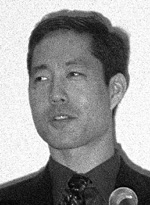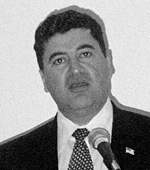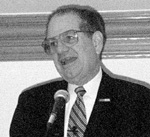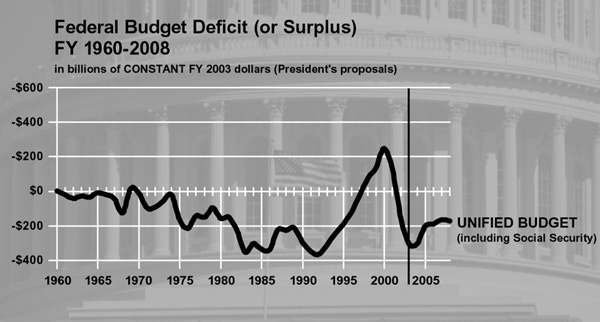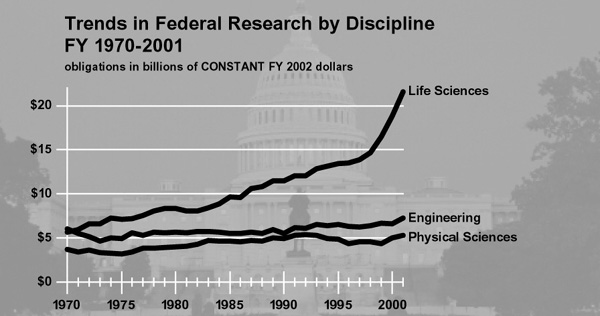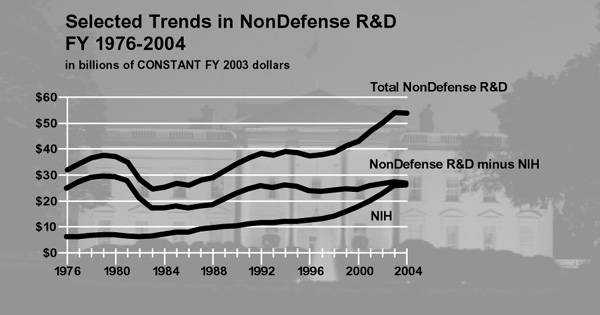 |
|
AAAS SCI TECH POLICY: Money, Science and History
by Mike Perricone Washington, D.C. - Big science in America celebrates its bicentennial this year with commemorations of the Corps of Discovery, commissioned by President Thomas Jefferson in 1803 to explore the new Northwest Territory of the $15-million,800,000-square-mile Louisiana Purchase.
Jefferson, and Capts. Merriwether Lewis and William Clark, also participated in the first major cost overrun in big science in America. The President requested $2,500 to finance the expedition. Its final cost was around $38,000 — although bringing with it an incalculable wealth of knowledge that is still a focus of attention. But at least one other aspect of big science was very different in those days, as Kei Koizumi told the 28th Colloquium on Science and Technology of the American Association for the Advancement of Science on April 10. “President Jefferson requested the funding, and a week later Congress approved it,” said Koizumi, who conducts the annual analysis of the Federal Budget for AAAS. A stark contrast with the current budget process and specifically the budget for FY2003, which Congress recently passed about midway through the fiscal year. With tax cuts, deepening deficits and uncertain costs for the war in Iraq, the budget demands what Koizumi called “tough priority choices,”primarily with constraints on domestic discretionary spending. Science and technology share in the constraints. Koizumi reported that funding for non-defense research and development would increase by one-tenth of one percent. Areas that have counted on substantial annual increases are seeing a slowdown. The National Science Foundation, currently the beneficiary of an authorization bill to double its funding over five years,fell about $900 million short of what the doubling track would have mandated. The National Institutes of Health has a 2.7 percent increase that represents a drop-off from double-digit increases now that its five-year doubling track has expired.
NIH Director Elias Zerhouni explained that the overall 2.7% increase included 7% specifically marked for research — and the recent funding trend gave that figure additional impact. “NIH is in marked transition from the 15 percent increase of FY03,” Zerhouni said.“But when your base has been doubled, seven percent is like 14 percent before the doubling.” Zerhouni cited examples of the stimulating effects of Federal investment. The number of NIH grants increased by 40 percent;the number of applications for grants increased by nearly 40 percent from 24,000 to 33,000;the average amount of Competing Research Grants grew from $255,000 in 1998 to $370,000 in 2003. As a consequence, medical schools have invested heavily in expanding:Zerhouni pointed to an additional 18 million square feet of space in medical school facilities,with increases in Ph.D.faculty ranging from an estimated 18,000 to 27,000. He also cited dramatic health benefits,using heart disease as an illustration. Zerhouni said that flat-flat budgeting between 1965 and 2000 would have projected statistically to 1.3 million heart disease deaths in 2000. Instead, heart disease caused 514,000 actual deaths in 2000,or a possible 815,000 lives saved as a correlation to increased spending. “If the funding curve flattens,”Zerhouni said, “it means we need more investment.” Funding wasn’t the only constraint on the Colloquium’s collective consciousness. The international nature of science, and the challenges posed by security restrictions, served as a continuing theme in panel discussions and plenary sessions. John Marburger, director of the Office of Science and Technology Policy, and science advisor to the President, devoted his entire keynote speech to the backlog in processing visas for foreign students and scientists (see accompanying story). That constraint is being felt throughout the scientific and academic communities.
Ray Orbach, Director of the Office of Science at the Department of Energy, gave his personal view that mending the strains on international collaboration is “critical to maintaining the international nature of science.” The Office of Science is the nation’s third-largest supporter of basic research, and the primary support for high-energy physics. “There are no boundaries in science. No country controls science,” Orbach said.“Science represents an international program of immense value to the entire world …I ’ve been trying to explain to other assistant secretaries that foreign scientists aren ’t here just to sample our science. In many cases they are running our science,they are running projects,they are in charge of detectors.It would be tragic if there is interference [from the current strains ]with the function of science.” A look back at the Corps of Discovery confirms the importance of international collaboration from the outset of American big science. On their journey, Lewis and Clark enlisted the aid of French-Canadian trapper Toussaint Charbonneau as a translator with Native American tribes. Charbonneau also brought an indispensable contributor to the expedition: his wife,Sacagawea, the Native American woman who guided the Corps of Discovery through the uncharted lands. As a woman and a Native American, Sacagawea would also be regarded today as representing segments of the population that are under- represented in American science. To Shirley Jackson, president of Rensselaer Polytechnic Institute and president-elect of AAAS, those under-represented segments of the population offer a valuable talent pool for the future —and perhaps a necessary talent pool. Jackson noted that while scientists and engineers make up just five percent of the U.S.workforce, they have had a profound impact over the last 50 years in America’s health, income, standard of living and ability to offer assistance to the world. She also noted that this “cohort ”of scientists and engineers,who have propelled the impact,is now close to retirement —an issue especially prominent, she said,in the National Aeronautics and Space Administration. But she feels the issue is not being adequately addressed, and she pointed with concern to static or declining enrollments in engineering and the physical sciences by U.S.students. “And I should know —I run a technological university,” Jackson said.
Foreign scientists and students are filling the gaps, but Jackson pointed to important changes: more foreigners are returning home, with jobs moving overseas and with Third World economies improving; and restrictions on immigration are particularly affecting the sciences and engineering. She cited RPI ’s historical links to students from Malaysia — a link that is now endangered. “We had 29 students recently who could not get their visas in time to enroll as freshmen,”Jackson said.“Now they’re looking toward Canada and Australia.” If the coming shortage cannot be addressed adequately from outside the country, Jackson said it could be addressed from within by what she called an “affirmative opportunity ” to build the workforce. She asserted that if women, minorities and people with disabilities held jobs in science and technology in proportion to their percentage of the population, there would be no shortage to address. But she also noted that U.S. high schools are consistently near the bottom of international rankings in science and math. “The effort can’t begin at the college classroom door,” Jackson said.“By then, it’s too late.” The changes Jackson believes are necessary would require a shift toward long-term thinking and planning. As the NIH has shown,even a slight shift, to a five-year strategy,can have unanticipated benefits. Just as,two hundred years later,we still have things to learn from the Corps of Discovery. “If you’re investing in science and technology with short-term hopes,”said Zerhouni,“then you’re not investing well.”
|
